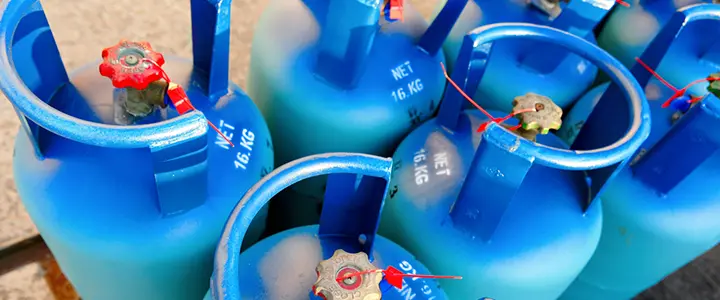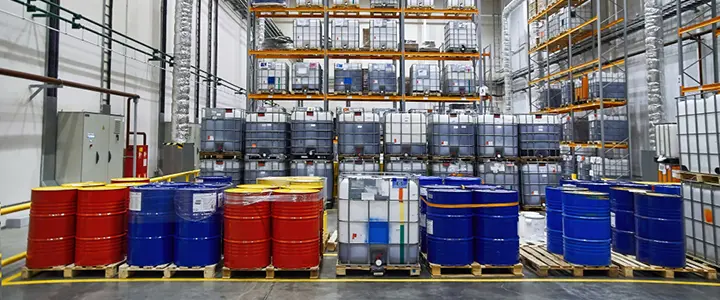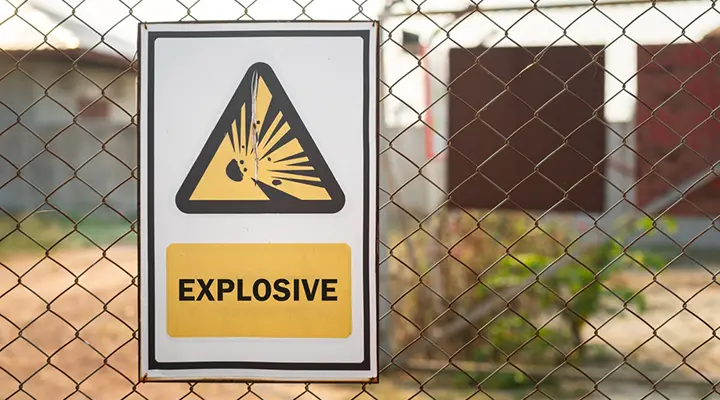Many businesses use or create substances that can harm people due to fire or explosion risks. The Dangerous Substances and Explosive Atmospheres Regulations 2002 (DSEAR) aim to protect people by addressing these risks.
This article will explain DSEAR, what employers must do to comply with DSEAR, and how it relates to the ATEX directives.
What is a Dangerous Substance?
A dangerous substance is any substance or mixture that can cause harm to people due to fire or explosion. This includes:
- Flammable liquids (e.g., petrol, acetone, ethanol, methanol, benzene)
- Flammable gases (e.g., acetylene, hydrogen, butane, LPG)
- Flammable dusts (e.g., powdered foodstuffs, wood dust, metal dust)
- Flammable solids (e.g., plastic foam, textiles, rubber)
- Substances corrosive to metals (e.g., sulfuric acid, phosphoric acid)
While dangerous substances are essential in many industries, they carry significant risks. The most critical concern is their ability to create explosive atmospheres, which can lead to catastrophic accidents if the risks are not properly controlled.
What is an Explosive Atmosphere?
An explosive atmosphere occurs when a dangerous substance mixes with air and in the right concentration can explode if exposed to an ignition source.
Explosive atmospheres can arise when:
- Flammable liquids are used at or above their flash point and give off vapour, forming an explosive mixture with air.
- Gases are released or leak into the air, creating an explosive mixture.
- Fine dust particles are suspended in the air and form a dust cloud that can be ignited and cause an explosion.
In the presence of an explosive atmosphere, even a small ignition source, such as a spark, static discharge or a small flame, can trigger a powerful explosion. The blast can propel flames in all directions, causing rapid and uncontrollable fire spread.
Accidents involving explosive atmospheres are often catastrophic. They can result in severe injuries, loss of life, and significant property damage. In many cases, they can force business operations to cease.
What is DSEAR?

The Dangerous Substances and Explosive Atmospheres Regulations 2002, or DSEAR for short, is legislation designed to safeguard employees and others from risks associated with hazardous substances in the workplace. The regulations require employers to assess the risks of fire, explosion, or similar incidents linked to dangerous substances and implement measures to prevent or control them.
Is DSEAR a legal requirement in the UK?
DSEAR is a legal requirement for employers in the UK.
Under the Health and Safety at Work Act 1974, employers must manage health and safety risks to their employees and others who may be affected by their activities. DSEAR complements the Health and Safety at Work Act 1974 by specifically addressing the risks posed by dangerous substances that can lead to explosive atmospheres, fires, or similar incidents in the workplace.
Failure to comply with DSEAR can result in legal consequences, including fines, prosecution, and potential business closure.
What must duty holders do to comply with DSEAR?
Duty holders (employers, self-employed individuals and those who manage or own premises) must take specific actions to comply with DSEAR:
- Find out what dangerous substances are in their workplace and assess the risks.
- Put control measures in place to either remove those risks or, where this is not possible, control them.
- Put controls in place to reduce the effects of any incidents involving dangerous substances.
- Identify and classify areas of the workplace where explosive atmospheres may occur and avoid ignition sources in those areas.
- Prepare plans and procedures to deal with accidents, incidents and emergencies involving dangerous substances.
- Make sure employees are properly informed about, and trained to deal with, the risks of dangerous substances.
When Do DSEAR Regulations Apply?
DSEAR applies to any workplace where dangerous substances are or are liable to be present, used, or produced. This includes situations where dangerous substances are:
- Stored and handled in the workplace
- Used as part of a work process
- Produced by a work activity as an end product, by-product, waste, or in accident conditions
- Naturally occurring in the work environment.
What Types of Activities Are Covered Under DSEAR?

DSEAR covers a wide range of activities that involve dangerous substances. Here are some examples:
- Storing petrol or diesel as fuel for vehicles, boats, agricultural machinery, and construction equipment.
- Using flammable solvents as cleaning agents.
- Spraying paints that produce flammable vapours in spray booths or workshops.
- Storing and displaying flammable goods, such as paints and lacquers, in shops.
- Handling, storing, and using gases in pressurised cylinders for industrial use, such as acetylene for cutting and welding.
- Woodworking, metal grinding, flour milling or blending, and other activities that generate fine dust particles.
- Storing grain, sugar, or feed in silos, which can produce combustible dust clouds.
- Producing, mixing, or storing chemicals.
- Work activities that release naturally occurring flammable substances, such as methane, at landfill sites or wastewater treatment.
- Handling and storing flammable waste like dust and fuel oils.
- Fermentation processes that produce flammable gases like ethanol vapour or carbon dioxide in breweries.
- Operating LPG-fuelled equipment or heating systems, such as industrial ovens or portable heaters.
- Transporting flammable substances in containers within the workplace.
- Storing and using oxygen.
- Handling and storing substances that are corrosive to metal.
What is the difference between DSEAR and ATEX?
ATEX and DSEAR both aim to manage and reduce risks associated with explosive atmospheres. However, they differ in their focus and where they apply.
ATEX refers to two European Directives that set the framework for controlling explosive atmospheres across the EU.
Directive 99/92/EC (ATEX 137 or the ATEX Workplace Directive)
The directive sets minimum safety requirements for employers to protect workers in environments where explosive atmospheres may occur.
Employers must carry out risk assessments, implement measures to prevent or reduce risks, classify hazardous areas, prepare emergency plans, and train employees.
In England, Scotland and Wales, this directive is implemented through the Dangerous Substances and Explosive Atmospheres Regulations 2002 (DSEAR).
Directive 2014/34/EU (ATEX 114 or the ATEX Equipment Directive)
The directive controls the design and certification of equipment and protective systems for use in potentially explosive atmospheres.
Manufacturers must meet strict testing, certification, and marking standards to ensure equipment is safe to use in specific hazardous areas.
In England, Scotland and Wales, this directive is implemented through the Equipment and Protective Systems Intended for Use in Potentially Explosive Atmospheres Regulations 2016 (EPS Regulations).
Dangerous Substances and Explosive Atmospheres Regulations 2002
The DSEAR regulations were introduced in 2002 as a result of two European Directive 98/24/EC and 99/92/EC. In 2015, amendments were made to also cover gases under pressure and substances that are corrosive to metals. The DSEAR regulations apply to all UK workplaces, and requires employers to:
- Carry out risk assessments, implement measures to prevent or reduce risks, classify hazardous areas, prepare emergency procedures, and train employees.
- Ensure that equipment and protective systems used in hazardous zones meet ATEX standards (via the EPS Regulations).



